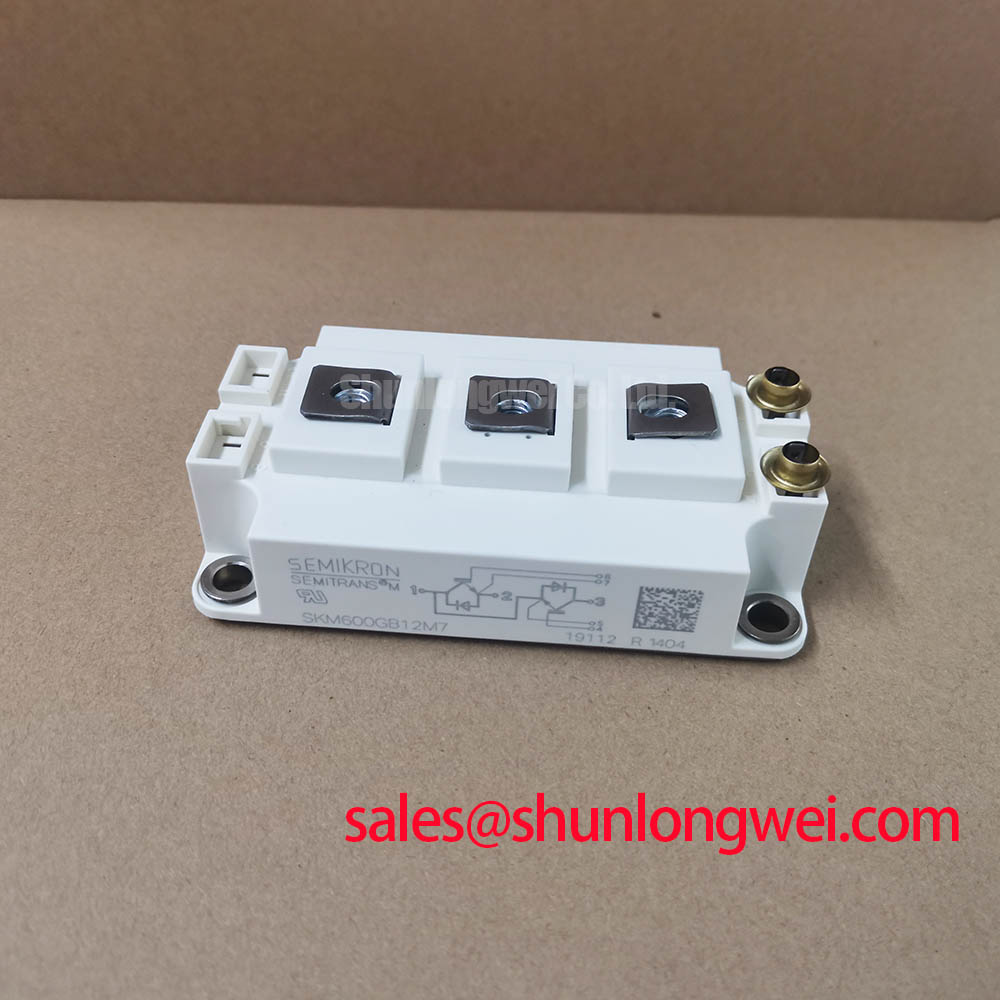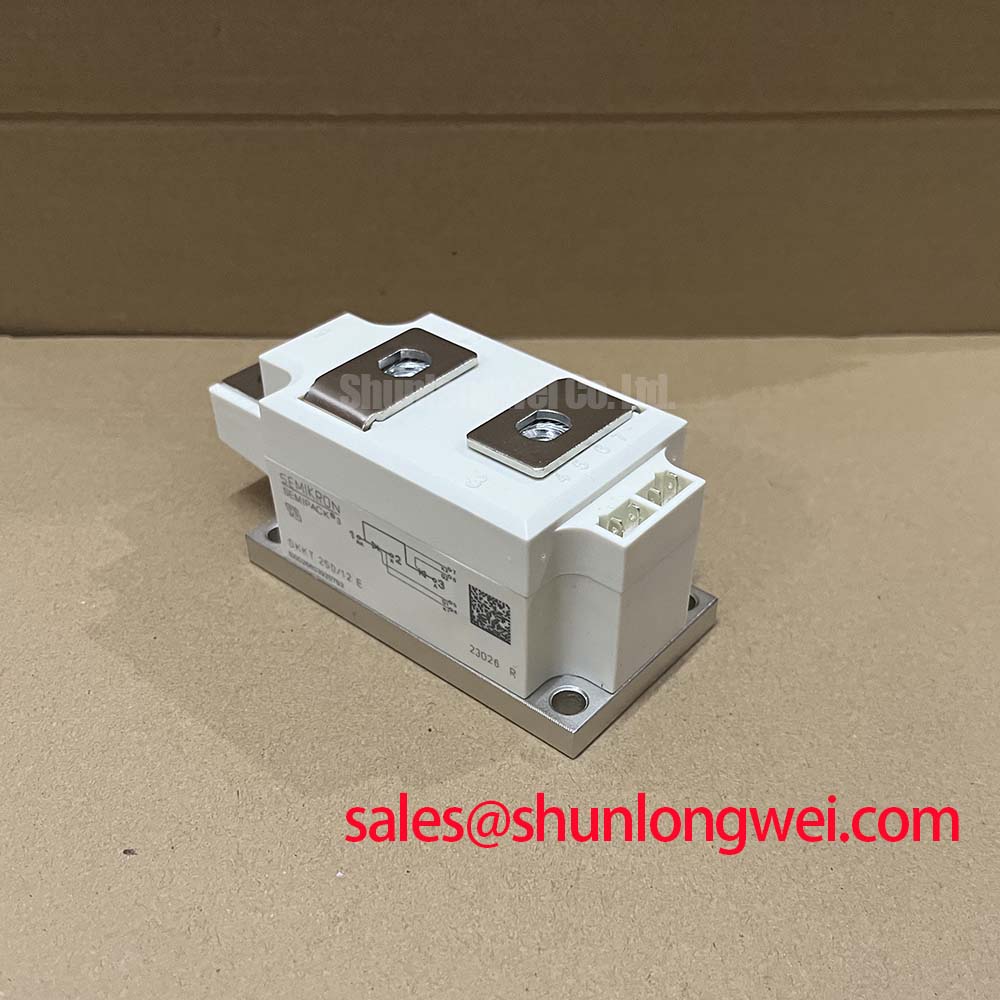Content last revised on October 28, 2025
SKM600GB12M7 | 1200V 600A IGBT Module for High-Efficiency Inverters
Product Overview: Core Specifications and Engineering Value
A High-Efficiency Power Stage for Demanding Industrial Applications
The Semikron SKM600GB12M7 is a half-bridge IGBT module engineered to deliver superior efficiency and thermal performance in high-power conversion systems. Its core value lies in the integration of advanced Trench IGBT 4 technology, which fundamentally reduces system-level losses. With specifications of 1200V | 600A (at Tc=80°C) | VCE(sat) 1.7V (typ), this module provides two key engineering benefits: significantly reduced conduction losses and enhanced thermal stability. This directly addresses the challenge of designing more compact, power-dense inverters without compromising on reliability or efficiency. For high-power industrial drives targeting stringent efficiency standards, the SKM600GB12M7's low loss profile makes it a definitive choice.
Application Scenarios & Value
Delivering System-Level Gains in High-Power Motor Drives and Inverters
The SKM600GB12M7 is engineered for applications where power conversion efficiency is a primary design driver. Its capabilities are best demonstrated in a high-fidelity engineering scenario such as the design of a 250kW industrial Variable Frequency Drive (VFD). In such systems, minimizing heat dissipation is critical to reducing heatsink size, enclosure volume, and overall system cost. The module's exceptionally low typical VCE(sat) of 1.7V at its nominal 600A rating directly lowers conduction losses during high-torque operation. This reduction is crucial for systems using high-frequency Pulse Width Modulation (PWM), as every saved watt reduces the burden on the thermal management system.
What is the primary benefit of its low VCE(sat)? It enables higher system efficiency and greater power density. This allows engineers to meet or exceed energy efficiency standards like IEC 61800-9-2, providing a competitive advantage. The module is also well-suited for large-scale solar inverters and uninterruptible power supplies (UPS), where long-term operational efficiency translates directly into lower total cost of ownership (TCO). For systems requiring lower current handling but similar 1200V blocking voltage, the related SKM400GB12T4 provides a scaled-down solution based on the same robust technology.
Key Parameter Overview
Highlighted Specifications for Performance-Critical Designs
The technical specifications of the SKM600GB12M7 are optimized for high-current, fast-switching applications. The values presented below are extracted from the official datasheet and highlight the parameters most critical for system design and performance simulation.
| Parameter | Symbol | Condition | Value |
| Collector-Emitter Voltage | VCES | Tj = 25 °C | 1200 V |
| Continuous Collector Current | IC,nom / IC | Tc = 25 °C / 80 °C | 795 A / 600 A |
| Collector-Emitter Saturation Voltage | VCE(sat) | Tj = 25 °C, IC = 600 A | 1.70 V (typ.) |
| Total Power Dissipation per IGBT | Ptot | Tc = 25 °C | 2950 W |
| Thermal Resistance, Junction to Case | Rth(j-c) | per IGBT | 0.050 K/W |
| Short Circuit Withstand Time | tsc | VCC = 800 V, VGE ≤ 15 V | 10 µs |
| Isolation Voltage | Visol | AC, 50 Hz; 1 min | 4000 V |
Download the SKM600GB12M7 datasheet for detailed specifications and performance curves.
Interpreting the Core Specification: VCE(sat)
The Collector-Emitter Saturation Voltage, VCE(sat), is a pivotal metric for efficiency. Think of it as the electrical "friction" the current experiences when the IGBT is fully turned on. A lower VCE(sat), such as the 1.7V typical value for the SKM600GB12M7, is analogous to a well-oiled mechanical system versus a rusty one. It means less energy is wasted as heat during the on-state, allowing more of the input power to be delivered to the load. This single parameter is a strong indicator of the module's ability to reduce conduction losses and improve overall inverter efficiency, a key goal in modern power electronic designs.
Technical Deep Dive
Inside the Trench 4 and CAL 4F Diode Technology
The performance of the SKM600GB12M7 is rooted in its advanced semiconductor technology, provided by the power electronics experts at Semikron. The module employs Trench IGBT 4 chips. Unlike older planar IGBT designs, the trench gate structure creates a vertical channel for current flow, significantly increasing the channel density. This design dramatically reduces the on-state resistance, which is the physical basis for the module's low VCE(sat) and reduced conduction losses.
Complementing the IGBT is the CAL 4F (Controlled Axial Lifetime) freewheeling diode. In a half-bridge configuration, the diode's performance is just as critical as the IGBT's. The CAL 4F diode is engineered for "soft" reverse recovery. This means it transitions from a conducting to a non-conducting state smoothly, without the abrupt current changes that can cause high-frequency ringing and voltage overshoots. What is the system-level impact of a soft-recovery diode? It significantly reduces electromagnetic interference (EMI), potentially simplifying or eliminating the need for bulky snubber circuits, and enhances the system's reliability by minimizing voltage stress on the components.
Frequently Asked Questions
Engineering Insights into the SKM600GB12M7's Core Features
How does the Trench IGBT 4 technology directly impact inverter efficiency?
The Trench IGBT 4 architecture creates a higher density of current-carrying channels compared to older planar technologies. This fundamentally lowers the on-state resistance, resulting in a lower VCE(sat). A lower VCE(sat) means less power is dissipated as heat during conduction, which directly translates to higher overall inverter efficiency.
What advantage does the CAL 4F freewheeling diode offer in hard-switching applications?
The CAL 4F diode is optimized for soft recovery characteristics. This minimizes voltage overshoot and oscillations during turn-off, reducing electrical stress on the IGBTs. It also lowers switching losses and generates less EMI, which can simplify system design and improve reliability under the demanding conditions of a hard-switched Servo Drive or VFD.
What is the significance of the Al2O3 substrate for the isolated copper baseplate?
The Aluminum Oxide (Al2O3) substrate serves two critical functions: it provides excellent thermal conductivity to efficiently transfer heat from the silicon chips to the heatsink, and it ensures high electrical isolation (rated at 4000V). This robust isolation simplifies mechanical mounting and enhances the safety and reliability of the overall power assembly.
For which power range is the SKM600GB12M7 most suitable?
Given its 1200V blocking voltage and 600A nominal current rating, this module is ideally suited for three-phase inverters in the 200kW to 350kW power class, operating on 400V to 690V AC lines. Its high efficiency makes it particularly advantageous for applications where minimizing energy loss is a primary objective.
Strategic Fit in Modern Power Systems
Enabling Future-Proof, High-Density Power Conversion
The SKM600GB12M7 is more than a component; it is an enabling technology for next-generation power converters. By leveraging advanced Trench 4 silicon, it provides engineers with the performance headroom to design systems that are not only more efficient but also more compact. The inherent reduction in losses allows for smaller heatsinks and enclosures, directly addressing the industry-wide trend toward higher power density. For organizations developing high-performance industrial automation, renewable energy, and power stability solutions, integrating a module with this level of efficiency is a strategic step toward creating more competitive and reliable end-products.


















